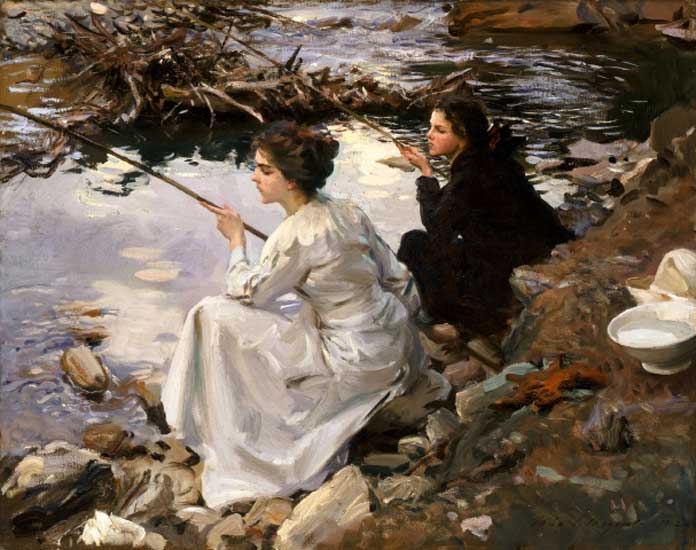Matthieu, for this exercise to be useful, the fewer values the better. As Howard Pyle said, "The fewer tones the simpler and better your pictures." As an exercise, try limiting it to two or three tones. You can do that by using markers or gouache, or by premixing pools of color in oil.
 |
| Dean Cornwell |
Sometimes it helps to think of families of values: a light family (with some variation in the tones) and a dark family (very much darker than any in the light family, but still distinguishable from each other).
Those big families of tone don't have to be close to white or black, by the way. The poetry of the Cornwell moonlight scene comes from handling those "whites" as a family of mid-range cool tones and saving the highest values for those sparkling windows.
Another thing to keep in mind is that it's not just how many values you have in your design, but how they're arranged.
 |
| Travels of the Soul by Howard Pyle |
In the painting above, Pyle has basically set up a light family and a dark family and has gradated between them. The impact of the design comes from that powerful grouping of the lights together into a single mass and the grouping of darks into a mysterious shadow.
Pyle told his students: "Put your white against white, middle tones (groups) against grays, black against black, then black and white where you want the center of interest. This sounds simple, but it is difficult to do."
 |
| John Singer Sargent, Two Girls Fishing, 1912, Cincinnati Art Museum |
These ideas were in the air when Pyle and Cornwell were working. Many other leading artists, such as John Singer Sargent were always grouping tones in arresting and memorable ways. If you check out any of the posts linked below, you can see more examples.
----
Previous related posts:
'What About that Rule?'
Posts that mention "Notan"
My other channels:
Instagram @jamesgurneyart
Facebook
Twitter
YouTube
Posts that mention "Notan"
My other channels:
Instagram @jamesgurneyart
YouTube







4 comments:
As a watercolour painter, I try to simplify to 3 main tones: light/medium/dark plus the white of the paper for highlights. It sounds easy but, as we know, there are several tonal values in between, and I then have to decide whether these are going to be light/medium or medium/dark.
Nice topic. Thanks. I've long been fascinated with the close and subtle value relationships of some 19th century painters, such as Jules Bastien-Lepage: https://www.metmuseum.org/art/collection/search/435621
This has been thought before, but ... it strikes me that a fundamental issue in one's thinking is whether you select an odd or an even number of points on your scale. If even, you deny yourself the cop-out option of the middle value. Four, for example, makes you choose between light and dark, with the subdivision of deep-dark, light dark, dark light and high light. There's no mid tone that way. gj
One of the fascinating things to me is that if you add more values, the eye tends to reduce to them to 3 anyways. Just squint and it starts happening anyways. Building the image from the get go with this issue in mind allows you to build your composition actively. When I see a modern artist do this, is when I really see a shift from photographic resemblance into independent image-creating. Great post!
Post a Comment